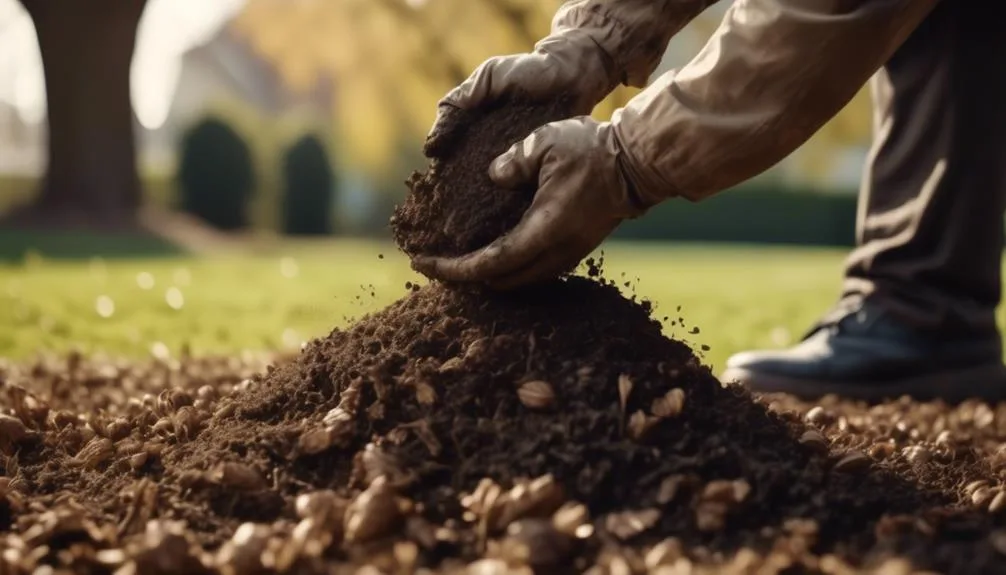If you want your walnut trees to thrive and produce a lot of nuts, you might be wondering how to improve the soil for them.
There are specific steps you can take to make sure the soil has the right nutrients and pH level for optimal growth.
From testing the soil to adding organic matter, these methods can help you create the best conditions for your walnut trees.
Let's explore how to improve the soil for walnut trees and set the stage for a great harvest.
Key Takeaways
- Conduct a thorough soil test to determine pH, nutrient levels, and composition.
- Adjust soil pH using materials like agricultural lime or elemental sulfur.
- Implement nutrient management strategies to support walnut tree growth and productivity.
- Add organic matter through compost, cover crops, and mulching techniques to improve soil health and water retention capacity.
Soil Testing for Walnut Trees
Before planting walnut trees, it's essential to conduct a thorough soil test to determine the soil's pH, nutrient levels, and composition. This test will provide crucial insights into the soil's ability to retain water and its drainage properties, which are vital for walnut tree growth.
By understanding the soil's water retention capacity, you can effectively plan irrigation strategies to ensure optimal moisture levels for your walnut trees. Additionally, the soil test will reveal if any drainage improvement measures are necessary to prevent waterlogging, which can be detrimental to walnut trees.
Armed with this knowledge, you can take proactive steps to amend the soil, such as incorporating organic matter or installing drainage systems, to create an optimal environment for your walnut trees to thrive.
Ph Adjustment for Walnut Trees
To optimize the growth of your walnut trees, it's crucial to ensure the pH of the soil is within the ideal range. Proper soil pH is essential for the trees to absorb nutrients effectively.
Here are some key steps to adjust the pH of the soil for your walnut trees:
- Test the Soil: Begin by testing the soil pH to determine its current level.
- Amending Soil: Based on the test results, consider using materials such as agricultural lime to raise the pH or elemental sulfur to lower it.
- Monitor Regularly: After making amendments, continue to monitor the soil pH regularly to ensure it remains within the optimal range for walnut tree growth.
Maintaining the appropriate soil pH through these steps will support the health and productivity of your walnut trees.
Nutrient Management for Walnut Trees
Optimizing the soil pH for your walnut trees not only ensures effective nutrient absorption but also lays the foundation for successful nutrient management to support their growth and productivity. Nutrient management is crucial for the health and yield of walnut trees. Implementing crop rotation and cover crops can significantly enhance the soil's nutrient content, promoting the overall well-being of your walnut trees.
Consider the following table for effective nutrient management:
| Nutrient | Purpose |
|---|---|
| Nitrogen | Stimulates leaf growth |
| Phosphorus | Supports root development |
| Potassium | Aids in fruit formation |
| Calcium | Essential for nut quality |
Organic Matter Addition for Walnut Trees
Adding organic matter to the soil is essential for enhancing the growth and productivity of your walnut trees. Consider these effective methods for organic matter addition:
- Compost Application: Incorporating compost into the soil provides essential nutrients and improves its structure, promoting better water retention and aeration.
- Cover Cropping Techniques: Utilizing cover crops such as legumes or grasses can add organic matter to the soil when they're turned under, enriching it with vital nutrients and enhancing its overall health.
- Mulching: Applying organic mulch such as wood chips or straw around the base of walnut trees helps to retain moisture, suppress weeds, and gradually add organic matter to the soil as it decomposes.
Mulching Techniques for Walnut Trees
Enhancing the health and productivity of your walnut trees can be achieved through implementing effective mulching techniques that contribute to soil moisture retention and weed suppression while gradually adding organic matter to the soil.
When mulching around walnut trees, aim for a layer of organic material about 2-4 inches thick. This helps to prevent water evaporation from the soil, ensuring adequate moisture for the trees, especially during dry periods.
Mulch also acts as a barrier, preventing weed growth that competes with walnut trees for essential nutrients and water. By suppressing weed growth, mulch allows walnut trees to thrive without the added stress of competition.
Additionally, as the mulch breaks down, it gradually adds organic matter to the soil, further enhancing its fertility and structure.
Conclusion
Incorporating these soil improvement techniques will create an ideal environment for your walnut trees to thrive.
By testing and adjusting the soil, managing nutrients, and adding organic matter, you can ensure that your trees receive the necessary support for healthy growth and a bountiful harvest.
This investment in your soil won't only benefit your walnut trees but also contribute to a sustainable and productive orchard for years to come.

